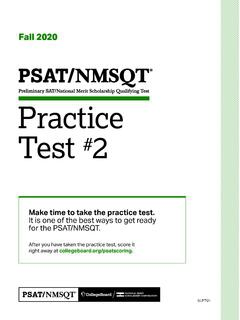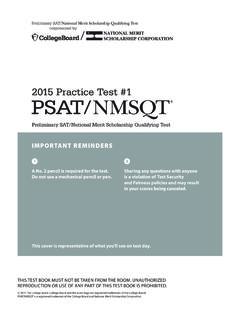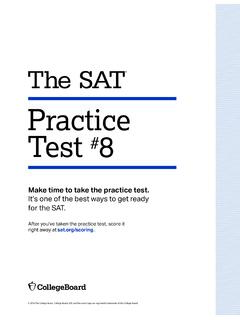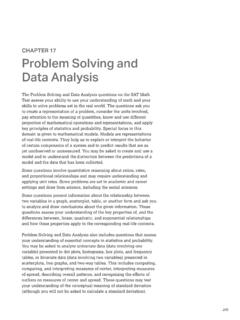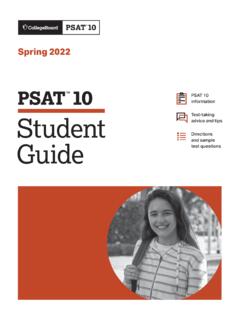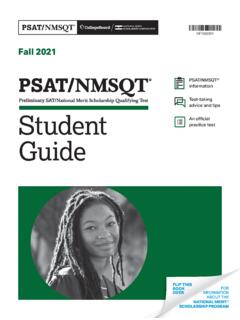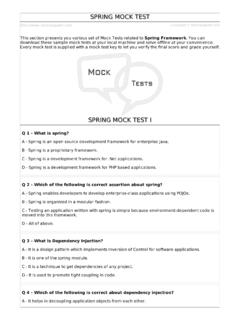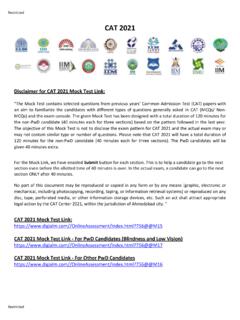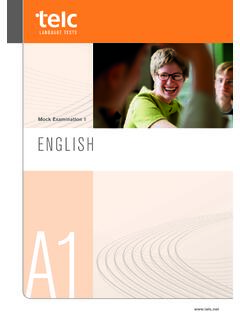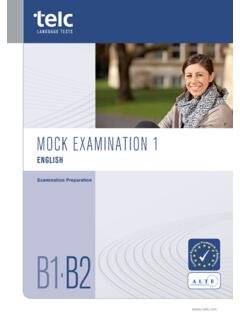Transcription of SAT Practice Test #1 | SAT Suite of Assessments – The ...
1 Practice Test 2016 The College Board. College Board, SAT, and the acorn logo are registered trademarks of the College time to take the Practice s one of the best ways to get ready for the you ve taken the Practice test, score it right away at begins on the next Test65 MINUTES, 52 QUESTIONSTurn to Section 1 of your answer sheet to answer the questions in this passage or pair of passages below is followed by a number of questions. After readingeach passage or pair, choose the best answer to each question based on what is stated orimplied in the passage or passages and in any accompanying graphics (such as a table orgraph).Questions 1-10 are based on the passage is from Lydia Minatoya,The Strangeness ofBeauty. 1999 by Lydia Minatoya. The setting is Japan in1920. Chie and her daughter Naomi are members of theHouse of Fuji, a noble came directly, breaking all tradition. Wasthat it? Had he followed form had he asked hismother to speak to his father to approach ago-between would Chie have been more receptive?
2 He came on a winter s eve. He pounded on thedoor while a cold rain beat on the shuttered veranda,so at first Chie thought him only the wind. The maidknew better. Chie heard her soft scuttling footsteps,the creak of the door. Then the maid brought acalling card to the drawing room, for was reluctant to go to her guest; perhaps shewas feeling too cozy. She and Naomi were reading ata low table set atop a charcoal brazier. A thick quiltspread over the sides of the table so their legs weretucked inside with the heat. Who is it at this hour, in this weather? Chiequestioned as she picked the name card off themaid s lacquer tray. Shinoda, Akira. Kobe Dental College, she recognized the name. Chie heard a softintake of air. I think you should go, said was waiting in the entry. He was in his earlytwenties, slim and serious, wearing the blackmilitary-style uniform of a student. As hebowed his hands hanging straight down, ablack cap in one, a yellow oil-paper umbrella in theother Chie glanced beyond him.
3 In the glisteningsurface of the courtyard s rain-drenched pavingstones, she saw his reflection like a dark double. Madame, said Akira, forgive my disruption,but I come with a matter of urgency. His voice was soft, refined. He straightened andstole a deferential peek at her the dim light his eyes shone with felt herself starting to like him. Come inside, get out of this nasty night. Surelyyour business can wait for a moment or two. I don t want to trouble you. Normally I wouldapproach you more properly but I ve received wordof a position. I ve an opportunity to go to America, asdentist for Seattle s Japanese community. Congratulations, Chie said with amusement. That is an opportunity, I m sure. But how am Iinvolved? Even noting Naomi s breathless reaction to thename card, Chie had no idea. Akira s message,delivered like a formal speech, filled her withmaternal amusement. You know how children speakso earnestly, so hurriedly, so endearingly aboutthings that have no importance in an adult s mind?
4 That s how she viewed him, as a copying or reuse of any part of this page is was how she viewed Naomi. Even thoughNaomi was eighteen and training endlessly in the artsneeded to make a good marriage, Chie had made noeffort to find her a blushed. Depending on your response, I may stay inJapan. I ve come to ask for Naomi s hand. Suddenly Chie felt the dampness of the night. Does Naomi know anything of We have an understanding. Please don t judgemy candidacy by the unseemliness of this proposal. Iask directly because the use of a go-between takesmuch time. Either method comes down to the samething: a matter of parental approval. If you give yourconsent, I become Naomi s yoshi.*We ll live in theHouse of Fuji. Without your consent, I must go toAmerica, to secure a new home for my bride. Eager to make his point, he d been looking her fullin the face. Abruptly, his voice turned gentle. I seeI ve startled you. My humble apologies.
5 I ll take nomore of your evening. My address is on my card. Ifyou don t wish to contact me, I ll reapproach you intwo weeks time. Until then, good night. He bowed and left. Taking her ease, with effortlessgrace, like a cat making off with a fish. Mother? Chie heard Naomi s low voice andturned from the door. He has asked you? The sight of Naomi s clear eyes, her dark browsgave Chie strength. Maybe his hopes werepreposterous. Where did you meet such a fellow? Imagine! Hethinks he can marry the Fuji heir and take her toAmerica all in the snap of his fingers! Chie waited for Naomi s ripe was silent. She stood a full half minutelooking straight into Chie s eyes. Finally, she spoke. I met him at my literary meeting. Naomi turned to go back into the house, thenstopped. Mother. Yes? I mean to have him. *a man who marries a woman of higher status and takes herfamily s name1 Which choice best describes what happens in thepassage?
6 A)One character argues with another characterwho intrudes on her ) One character receives a surprising request fromanother ) One character reminisces about choices she hasmade over the ) One character criticizes another character forpursuing an unexpected course of choice best describes the developmentalpatternof the passage?A) A careful analysis of a traditional practiceB) A detailed depiction of a meaningful encounterC) A definitive response to a series of questionsD) A cheerful recounting of an amusing anecdote3As used in line 1 and line 65, directly mostnearlymeansA) ) ) without ) with reaction does Akira most fear from Chie?A)She will consider his proposal ) She will mistake his earnestness for ) She will consider his unscheduled visit ) She will underestimate the sincerity of copying or reuse of any part of this page is choice provides the best evidence for theanswerto the previous question?A) Line 33 ( His )B) Lines 49-51 ( )C) Lines 63-64 ( )D) Lines 71-72 ( )6In the passage, Akira addresses Chie withA)affection but not genuine ) objectivity but not complete ) amusement but not mocking ) respect but not utter main purpose of the first paragraph is toA)describe a ) criticize a ) question a ) analyze a used in line 2, form most nearly meansA) ) ) ) does Akira say his meeting with Chie is amatter of urgency (line 32)?
7 A) He fears that his own parents will disapprove ) He worries that Naomi will reject him and marrysomeone ) He has been offered an attractive job in ) He knows that Chie is unaware of his feelings choice provides the best evidence for theanswerto the previous question?A) Line 39 ( I don )B) Lines 39-42 ( )C) Lines 58-59 ( )D) Lines 72-73 ( I ) copying or reuse of any part of this page is 11-21 are based on the followingpassage and supplementary passage is adapted from Francis J. Flynn and GabrielleS. Adams, "Money Can't Buy Love: Asymmetric Beliefs aboutGift Price and Feelings of Appreciation." 2008 by day, millions of shoppers hit the stores infull force both online and on foot searchingfrantically for the perfect gift. Last year, Americansspent over $30 billion at retail stores in the month ofDecember alone. Aside from purchasing holidaygifts, most people regularly buy presents for otheroccasions throughout the year, including weddings,birthdays, anniversaries, graduations, and babyshowers.
8 This frequent experience of gift-giving canengender ambivalent feelings in gift-givers. Manyrelish the opportunity to buy presents becausegift-giving offers a powerful means to build strongerbonds with one s closest peers. At the same time,many dread the thought of buying gifts; they worrythat their purchases will disappoint rather thandelight the intended describe gift-giving as a positivesocial process, serving various political, religious, andpsychological functions. Economists, however, offera less favorable view. According to Waldfogel (1993),gift-giving represents an objective waste of buy gifts that recipients would not choose tobuy on their own, or at least not spend as muchmoney to purchase (a phenomenon referred to as the deadweight loss of Christmas ). To wit, giversare likely to spend $100 to purchase a gift thatreceivers would spend only $80 to buy deadweight loss suggests that gift-givers arenot very good at predicting what gifts others willappreciate.
9 That in itself is not surprising to socialpsychologists. Research has found that people oftenstruggle to take account of others perspectives their insights are subject to egocentrism, socialprojection, and multiple attribution is surprising is that gift-givers haveconsiderable experience acting as both gift-givers andgift-recipients, but nevertheless tend to overspendeach time they set out to purchase a meaningful the present research, we propose a uniquepsychological explanation for this overspendingproblem , that gift-givers equate how much copying or reuse of any part of this page is with how much recipients will appreciate thegift (the more expensive the gift, the stronger agift-recipient s feelings of appreciation). Although alink between gift price and feelings of appreciationmight seem intuitive to gift-givers, such anassumption may be unfounded. Indeed, we proposethat gift-recipients will be less inclined to base theirfeelings of appreciation on the magnitude of a giftthan givers do gift-givers assume that gift price is closelylinked to gift-recipients feelings of appreciation?
10 Perhaps givers believe that bigger ( , moreexpensive) gifts convey stronger signals ofthoughtfulness and consideration. According toCamerer (1988) and others, gift-giving represents asymbolic ritual, whereby gift-givers attempt to signaltheir positive attitudes toward the intended recipientand their willingness to invest resources in a futurerelationship. In this sense, gift-givers may bemotivated to spend more money on a gift in order tosend a stronger signal to their intended for gift-recipients, they may not construe smallerand larger gifts as representing smaller and largersignals of thoughtfulness and notion of gift-givers and gift-recipients beingunable to account for the other party s perspectiveseems puzzling because people slip in and out ofthese roles every day, and, in some cases, multipletimes in the course of the same day. Yet, despite theextensive experience that people have as both giversand receivers, they often struggle to transferinformation gained from one role ( , as a giver)and apply it in another, complementary role ( , asa receiver).
